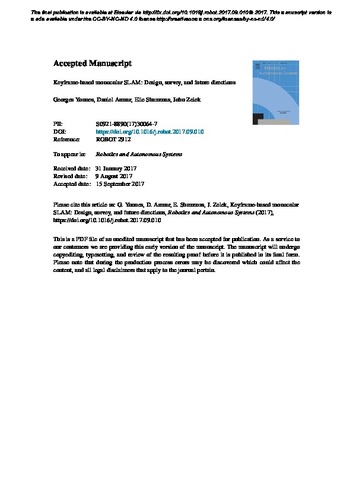| dc.contributor.author | Younes, Georges | |
| dc.contributor.author | Asmar, Daniel | |
| dc.contributor.author | Shammas, Elie | |
| dc.contributor.author | Zelek, John | |
| dc.date.accessioned | 2017-11-16 17:24:51 (GMT) | |
| dc.date.available | 2017-11-16 17:24:51 (GMT) | |
| dc.date.issued | 2017-12-01 | |
| dc.identifier.uri | http://dx.doi.org/10.1016/j.robot.2017.09.010 | |
| dc.identifier.uri | http://hdl.handle.net/10012/12631 | |
| dc.description | The final publication is available at Elsevier via http://dx.doi.org/10.1016/j.robot.2017.09.010 © 2017. This manuscript version is made available under the CC-BY-NC-ND 4.0 license http://creativecommons.org/licenses/by-nc-nd/4.0/ | en |
| dc.description.abstract | Extensive research in the field of monocular SLAM for the past fifteen years has yielded workable systems that found their way into various applications in robotics and augmented reality. Although filter-based monocular SLAM systems were common at some time, the more efficient keyframe-based solutions are becoming the de facto methodology for building a monocular SLAM system. The objective of this paper is threefold: first, the paper serves as a guideline for people seeking to design their own monocular SLAM according to specific environmental constraints. Second, it presents a survey that covers the various keyframe-based monocular SLAM systems in the literature, detailing the components of their implementation, and critically assessing the specific strategies made in each proposed solution. Third, the paper provides insight into the direction of future research in this field, to address the major limitations still facing monocular SLAM; namely, in the issues of illumination changes, initialization, highly dynamic motion, poorly textured scenes, repetitive textures, map maintenance, and failure recovery. | en |
| dc.description.sponsorship | ENPI (European Neighborhood Partnership Instrument) [I-A/1.2/113] | en |
| dc.description.sponsorship | Lebanese National Research Council [LNCSR-103089] | en |
| dc.description.sponsorship | Canadian National Science Research Council, NSERC [RGPIN-2017-04254] | en |
| dc.language.iso | en | en |
| dc.publisher | Elsevier | en |
| dc.rights | Attribution-NonCommercial-NoDerivatives 4.0 International | * |
| dc.rights.uri | http://creativecommons.org/licenses/by-nc-nd/4.0/ | * |
| dc.subject | Keyframe Based | en |
| dc.subject | Monocular | en |
| dc.subject | Visual Slam | en |
| dc.title | Keyframe-based monocular SLAM: design, survey, and future directions | en |
| dc.type | Article | en |
| dcterms.bibliographicCitation | Younes, G., Asmar, D., Shammas, E., & Zelek, J. (2017). Keyframe-based monocular SLAM: design, survey, and future directions. Robotics and Autonomous Systems, 98(Supplement C), 67–88. https://doi.org/10.1016/j.robot.2017.09.010 | en |
| uws.contributor.affiliation1 | Faculty of Engineering | en |
| uws.contributor.affiliation2 | Systems Design Engineering | en |
| uws.typeOfResource | Text | en |
| uws.typeOfResource | Text | en |
| uws.peerReviewStatus | Reviewed | en |
| uws.scholarLevel | Faculty | en |


